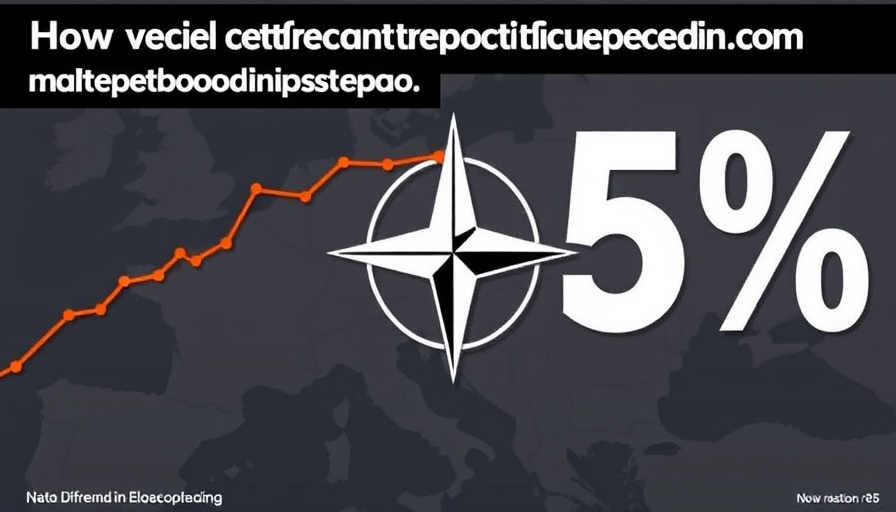
Understanding NATO's New 5% Pledge and Its Implications
The recent commitment by NATO to hike defense spending to 5% has raised eyebrows not just among political analysts, but also among investors keen to understand how military investments could shape broader economic trends. With NATO's recent directive, member nations are now facing the challenge of reallocating their budgets to boost military expenditures significantly.
Historically, NATO countries have struggled to meet the previous benchmark of spending 2% of their GDP on defense. The agreement to raise that figure to 5% reflects the growing urgency among member countries to bolster military readiness amid rising global tensions. This move comes in the context of heightened geopolitical risks, including conflicts involving major powers and increased regional instability. From an investment perspective, it presents both opportunities and challenges that should not be ignored.
Financial Markets React to Increased Defense Spending
As countries sharpen their focus on defense, market analysts are observing a corresponding rise in defense-related stocks. Companies that manufacture military equipment and technological solutions are likely to see increased demand for their products. This uptick in defense spending leads to speculation that such stocks might become attractive investments.
For those interested in stock market news, keeping an eye on firms involved in defense contracts could offer investment strategies that align with this trend. Stocks in companies like Lockheed Martin and Northrop Grumman might be poised for growth as military budgets swell. For investors focusing on portfolio diversification, these stocks might serve as solid additions, balancing risk amid broader market volatility.
Implications for Mutual Funds and ETFs
The rise in defense spending can significantly affect mutual funds and ETF investing strategies. Funds that focus on defense and aerospace sectors will likely see inflows as more investors turn to sectors that could benefit from government spending increases. By investing in sector-specific funds, investors can harness the expected growth in defense-related industries.
Additionally, with high military expenditures often leading to technological innovations, investing in funds that emphasize both defense and technology could yield dividends in the long run. For those interested in investment strategies, diversification into defense assets may offer one way to hedge against economic downturns, which could arise from geopolitical tensions.
Real Estate Investing in Defense-Heavy Regions
Beyond equities, the additional defense spending could also positively impact the real estate investing landscape in regions surrounding military installations. Areas that traditionally host military bases frequently experience growth in housing demand as contractors and military personnel move in. This could be an inviting prospect for real estate investment trusts (REITs) concerned with commercial properties.
Investors in the real estate market may consider focusing on properties in defense-heavy regions, where increased spending might bolster the local economy, driving both residential and commercial property values upward.
Potential Challenges and Risks to Watch
While there are potential benefits from increased defense spending, there are also significant risks involved. Critics argue that such a heavy focus on military budgets could divert necessary funds away from vital public services, including education and healthcare. Hence, investors need to consider the broader implications of these economic shifts.
Moreover, should the global financial landscape experience shifts—perhaps through increased inflation or supply chain disruptions—the anticipated benefits from enhanced military spending could be mitigated. Understanding these risk factors is crucial for sound portfolio management and informed decision-making.
Future Predictions: Impact on Global Markets
The ongoing commitment to defense spending sets a trajectory that could redefine market dynamics across several sectors. With global volatility on the rise, sustained investment in military capabilities is likely to shift priorities in government spending, which may inadvertently impact other areas of the economy.
In the coming years, we could see a balancing act between defense and other forms of public spending, especially as nations navigate the complexities of economic recovery and social responsibility. Investors should remain alert for emerging opportunities in both the defense sector and related industries while also staying aware of the potential for backlash against increased military funding.
Concluding Thoughts: Adjusting Investment Strategies
In summary, NATO’s push for increased defense spending opens up numerous avenues for investors seeking to align their strategies with global trends. From focusing on sector-specific mutual funds to exploring real estate opportunities, there are plenty of ways to diversify portfolios to hedge against future risks.
With a clear understanding of market dynamics and the geopolitical landscape, investors can strategically position themselves to capitalize on the shifts in defense spending and the wider implications for global economies.
 Add Row
Add Row  Add
Add 



Write A Comment